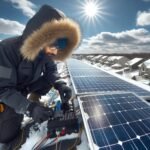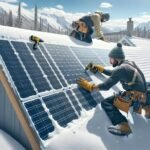Ever wondered why your neighbor’s DIY solar project didn’t quite pan out? While the allure of cutting energy costs and going green is strong, the reality of executing a flawless solar installation is often more complex than it seems. Did you know that nearly 40% of DIY solar installations encounter significant issues within the first year?
So, what went wrong with your neighbor’s setup? From improper panel placement to inadequate electrical connections, the pitfalls are numerous and often overlooked by enthusiastic DIYers. Understanding these common mistakes can save you time, money, and a lot of frustration.
By diving into the reasons behind these failures, you’ll not only learn how to avoid them but also set yourself up for a successful and efficient solar power system. Ready to turn sunlight into savings without the headaches? Let’s get into it.
Common Reasons for DIY Solar Install Failures
You might look at your neighbor’s failed DIY solar install and wonder, “What went wrong?” More often than not, common issues arise that can derail even the most well-intentioned solar projects.
 how to save thousands on your solar setup: a canadian’s guide
how to save thousands on your solar setup: a canadian’s guideInadequate Planning
Inadequate planning is one of the primary reasons for DIY solar failures. Did your neighbor consider the optimal positioning for their solar panels? Perhaps not. Without careful planning, your panels might end up in shaded areas, significantly reducing their efficiency.
You also need to consider your home’s energy needs, roof’s structural integrity, and weather patterns. A detailed site assessment ensures your solar panels capture the most sunlight. Think of it like planning a garden – you wouldn’t just throw seeds anywhere, right? Researching and measuring before installation sets you up for success.
Poor Installation Quality
Even if you’ve planned everything perfectly, poor installation quality can sabotage your efforts. Ever noticed that some DIY projects look a bit… off? Same goes for solar panels. If the mounting isn’t secure, panels could shift or even come loose. Wiring mishaps are also common, leading to electrical inefficiencies or hazards.
Professionally installed systems adhere to stringent quality standards. If you go DIY, ensure you have the right tools and skills. Have you ever tried installing a ceiling fan only to find it’s wobbling? Imagine that on a larger, more vital scale with solar panels. Quality matters.
Read also: how to save thousands on your solar setup: a canadian’s guide
how to save thousands on your solar setup: a canadian’s guide avoid these common diy solar wiring mistakes in your canadian home
avoid these common diy solar wiring mistakes in your canadian homeIncorrect Sizing
Another pitfall is incorrect sizing. Did your neighbor install too few or too many panels for their energy consumption? Incorrectly sized systems can lead to inefficiencies and higher costs. You need to calculate your household’s average energy usage to determine the correct number of panels.
Sizing isn’t just about the number of panels; it’s also about their capacity. It’s like buying shoes – you need the right size for comfort and performance. Oversized systems waste resources; undersized ones won’t meet your needs. Precision is key here.
Ignoring Local Regulations
Ignoring local regulations is a mistake that can cost you dearly. Solar installations are subject to building codes, permits, and even homeowner association rules. Skipping this step could mean fines or having to tear down your system.
It’s crucial to research local regulations before starting. Just like you wouldn’t build an addition to your home without checking local building codes first, your solar installation needs the same attention to legal details. Local governments often offer resources – think rebates and incentives – that you’d miss out on otherwise.
Read also: how to save thousands on your solar setup: a canadian’s guide
how to save thousands on your solar setup: a canadian’s guide avoid these common diy solar wiring mistakes in your canadian home
avoid these common diy solar wiring mistakes in your canadian home solar panel mounting 101: tips for canadian roofs and weather
solar panel mounting 101: tips for canadian roofs and weatherIf you’re considering following in your neighbor’s footsteps but want to avoid their pitfalls, meticulous planning and professional consultation can go a long way. For more insight into a seamless solar lifestyle, explore our detailed guides on Solar Panels for Life.
Technical Challenges in DIY Solar Installs
So, you’re thinking of diving into the solar lifestyle with a DIY solar panel installation? Let’s take a closer look at some technical challenges you might encounter.
Electrical Connections
Proper electrical connections are the backbone of any solar panel system. A common hurdle in DIY projects is ensuring everything is wired correctly – one small mistake can lead to inefficiencies or even safety hazards. Ever wondered why your neighbor’s lights flicker? It could be due to loose or improper wiring.
Connecting your solar panels involves dealing with inverters, breakers, and wiring configurations. If you’re not familiar with terms like “inverter efficiency” or “load balancing,” it’s easy to get things wrong. Incorrect connections can cause higher resistance in the circuit, leading to energy loss. Imagine running a marathon in flip-flops – not very efficient, right?
Read also: how to save thousands on your solar setup: a canadian’s guide
how to save thousands on your solar setup: a canadian’s guide avoid these common diy solar wiring mistakes in your canadian home
avoid these common diy solar wiring mistakes in your canadian home solar panel mounting 101: tips for canadian roofs and weather
solar panel mounting 101: tips for canadian roofs and weather diy solar installation: is it really worth it for canadian homeowners?
diy solar installation: is it really worth it for canadian homeowners?Before you start, it’s wise to consult a certified electrician. They’ll help you understand the voltage requirements and ensure your setup meets safety standards. A simple oversight could negate any government incentives or rebates you’re eligible for.
Roof Compatibility
Not all roofs are created equal when it comes to supporting solar panels. The type of roof you have can significantly impact the installation process and the efficiency of your system. Flat roofs, for instance, pose different challenges compared to pitched roofs. Is your roof strong enough to hold the weight of solar panels?
Also, the material of your roof plays a crucial role. Asphalt shingles, metal roofs, and tile roofs each have their own compatibility issues. For example, installing on a tile roof might require specialized mounting equipment to avoid damage. Too often, DIY enthusiasts skip this step, leading to costly repairs down the line.
Also, consider roof age. An older roof may not withstand the installation process, making it essential to inspect and possibly repair or replace the roof before proceeding. Overlooking this aspect could lead to water leaks and structural damage, nullifying the benefits of your new solar panels.
Weather Considerations
Weather is an unpredictable yet critical factor in solar panel performance. Solar panels are built to withstand various weather conditions, but DIY installations might not always account for local climate nuances. Have you thought about how your region’s weather could impact your system?
Heavy snowfall can burden poorly secured panels, while high winds can dislodge them if not properly anchored. Another often overlooked factor is your region’s sun exposure. A backyard full of shade won’t make for an efficient solar setup.
Planning for these scenarios requires not only an understanding of your local weather patterns but also the ability to adjust the installation accordingly. Protective measures like ensuring proper tilt angles and secure mounts can prevent weather-related issues. Ignoring these could lead to underperformance or even equipment damage.
Pros of DIY Solar Installations
Going the DIY route with solar panels has its own unique benefits. Curious about what could make a do-it-yourself solar project worth the effort? Let’s jump into the perks!
Cost Savings
One of the biggest reasons people opt for a DIY solar install? The potential for significant cost savings. Professional installations can be pricey, sometimes reaching up to CAD 25,000. By tackling the project yourself, you can save on labor costs, which often constitute a big chunk of the total expense.
Consider this: when you install your own solar panels, you avoid the markups and fees associated with professional services. Plus, various government incentives, tax credits, and rebates can make your project even more affordable.
Have spare time on the weekends? Channel that time into creating your own solar lifestyle. You’ll likely be more invested in the outcome and meticulous about the details, ensuring that those panels are positioned perfectly to maximize efficiency.
Learning Experience
Let’s face it: there’s something intrinsically rewarding about rolling up your sleeves and handling a project yourself. A DIY solar installation can be an incredible learning experience. From understanding the intricacies of solar panel technology to mastering the nuances of electrical connections, the hands-on engagement offers valuable knowledge.
Think of it as a crash course in renewable energy. You get to dive deep into the world of solar panels and emerge as a bit of an expert. Rhetorical question: Who wouldn’t want that kind of knowledge under their belt?
And let’s not forget the empowerment factor. Every time you see those solar panels converting sunlight into electricity, you’ll remember the effort, sweat, and smarts you put into making it happen. That’s not just a learning experience; that’s a lifetime badge of honor.
So, if you’re considering entering the world of solar energy, why not explore the DIY route? Of course, while it has its benefits, always remember to weigh these against potential pitfalls to ensure a smooth and successful project. For more detailed guides and quality solar panels, visit Solar Panels for Life—your one-stop destination for all things solar.
Cons of DIY Solar Installations
Opting for a DIY solar installation might seem like a great way to embrace the solar lifestyle and save on labor costs. But, several pitfalls can make this route less appealing than hiring professionals. Here are some of the most significant cons that you should be aware of.
Potential Safety Hazards
Have you ever wondered what happens if you miswire a solar panel? The stakes are high. DIY solar installations present several safety hazards that can be dangerous if not properly managed. For example, incorrect electrical connections can lead to short circuits or fires. Climbing onto your roof to install panels can also pose physical risks, particularly if you’re not accustomed to working at heights or don’t have the proper safety equipment.
Let’s not forget about the potential for damaging your property. Improperly installed panels can lead to roof leaks, which might require costly repairs down the line. Certified professionals are trained to avoid these pitfalls, so this is a major point to consider. A minor mistake could result in a major headache—and who needs that?
Lack of Professional Warranty
Warranties, anyone? One of the most significant drawbacks of a DIY solar install is the lack of a professional warranty. When you opt for professional installation, the service often comes with warranties on both the panels and the installation work. These warranties can be a lifesaver if something goes wrong with your system.
In contrast, if you install the panels yourself and something breaks or isn’t functioning correctly, you’re left to troubleshoot and bear the repair costs. This absence of a safety net can turn what seemed like a cost-saving venture into an expensive ordeal. So, while DIY might save you money upfront, the long-term risks should make you pause and reconsider.
Time-Consuming Process
Is your time really yours to spare? DIY solar installation is a time-consuming try that requires meticulous planning, purchasing, and actual hands-on labor. What might take a professional team a few days could stretch into weeks or even months if you’re handling it on your own.
This extensive time requirement can be frustrating, particularly if you run into issues along the way. Do you know exactly how to size your system, or how to handle net metering setup? The learning curve is steep, meaning this isn’t just a weekend project; it’s a significant commitment.
Even though the potential cost savings and the rewarding aspect of taking on a DIY project, the time investment required can be overwhelming. Before diving in, ask yourself if you’re prepared for the dedication it will require. There are better ways to enjoy the solar lifestyle without sacrificing countless hours in the process—such as exploring more straightforward paths with Solar Panels for Life.
How to Avoid DIY Solar Installation Failures
Thinking about installing solar panels yourself? It’s entirely possible—but only if you do it right. Let’s explore how to avoid common pitfalls.
Proper Planning and Research
Proper planning and research are fundamental to avoiding DIY solar installation failures. First, understand your energy needs. How much electricity does your household consume? This helps you determine the size of your solar system. Research site conditions—do you have enough unobstructed sunlight? This can be trickier than you think. Does your roof angle and orientation support optimal sunlight capture? Next, investigate into the intricacies of solar technology. Are you familiar with terms like “photovoltaic cells” or “inverter”? If not, take the time to learn. Comprehensive research ensures you choose appropriate equipment and avoid future headaches.
Quality Equipment Selection
Quality equipment can make or break your solar project. It might be tempting to cut costs by purchasing cheap solar panels, but this often leads to subpar performance and frequent breakdowns. Investing in high-quality panels and inverters can save you money in the long run through better efficiency and durability. Be sure to check for certifications and reviews. Look for industry-standard certifications like IEC for panels or UL for inverters—these ensure performance and safety. Remember, at Solar Panels for Life, we stress the importance of quality because your solar lifestyle depends on it.
Compliance with Local Regulations
Ignoring local regulations is a fast track to a failed DIY solar installation. Complying with local codes is not just about avoiding fines—it’s also about ensuring your installation is safe and eligible for incentives. Research zoning laws, building codes, and any specific electrical standards that apply in your area. Are there restrictions on the number of panels you can install? Do you need a permit? Also, consider potential government incentives. Various tax credits, rebates, and grants can significantly offset your initial investment. By adhering to local regulations, you pave the way for a smoother and legally compliant installation process.
Seeking Professional Guidance
Do you really want to gamble with your investment? While DIY projects can be rewarding, seeking professional guidance can significantly reduce the risk of errors. Consulting with certified electricians or solar installation experts can provide validation for your plans and highlight any overlooked issues. Plus, many professionals offer initial consultations free of charge or at a minimal cost—a small price to avoid costly mistakes. At Solar Panels for Life, we often recommend a hybrid approach: do some of the work yourself, but don’t hesitate to call in the pros for the more technical aspects. This way, you get the best of both worlds.
Professional Solar Installation Advantages
You might be wondering why professional solar installation could be a better route. After all, DIY projects can be rewarding. But let’s investigate into the advantages you get when you bring in the experts.
Expert Knowledge
Ever tried to fix something yourself only to realize it’s more complicated than you thought? Solar panel installation is no different. Professionals bring invaluable expertise, understanding intricate electrical systems and optimal panel placements. These experts know the ins and outs of local regulations, ensuring you avoid those pesky fines and access all available incentives.
You wouldn’t want to miss out on tax credits or rebates, right? With professionals like Solar Panels for Life in your corner, you can rest easy knowing every step is done by the book, maximizing both efficiency and savings.
Professional Equipment And Tools
Imagine trying to assemble a complex piece of furniture with a pocket knife. Not ideal, right? Professional installers come equipped with specialized tools that DIYers likely don’t have sitting in their garage. These tools ensure a precise and secure installation, critical for both performance and safety.
High-quality crimpers, insulated screwdrivers, and advanced metering devices might sound like jargon, but they’re essential for a flawless install. Trust us, these tools can be the difference between efficient energy production and a system that barely works.
Time Efficiency
Your time is valuable. Installing solar panels isn’t a weekend project. It requires detailed planning, fortitude, and numerous hours. For many, time is a precious resource spent juggling work, family, and hobbies.
Professionals can complete an installation in a fraction of the time it would take you. They know the drill—literally and figuratively. This efficiency means you can start enjoying the benefits of solar energy sooner, and who doesn’t want lower electricity bills faster?
Warranty And Support
Here’s a scenario—your DIY solar installation is up and running, but a month later, something goes wrong. Now what? Unlike a DIY project, professional installations often come with warranties and ongoing support. This means if a problem crops up, you’re not left in the lurch.
Think of it as having an insurance policy for your solar lifestyle. Besides, with companies like Solar Panels for Life, you can expect stellar customer service and continuous support, ensuring your system runs smoothly for years to come.
Have questions about your specific needs or looking for detailed guides? Don’t hesitate to explore our resources at Solar Panels for Life.
Conclusion
Exploring a DIY solar install can be daunting but understanding the common pitfalls can save you from costly mistakes. Proper planning and research are essential to assess your energy needs and site conditions. Selecting quality equipment and adhering to local regulations can make a significant difference in the success of your project.
While DIY installations offer cost savings and a rewarding learning experience they come with risks that shouldn’t be underestimated. Consulting professionals for complex tasks can ensure safety and efficiency maximizing your investment in solar energy.
For more detailed guides and top-quality solar panels visit Solar Panels for Life—your one-stop destination for all things solar.
